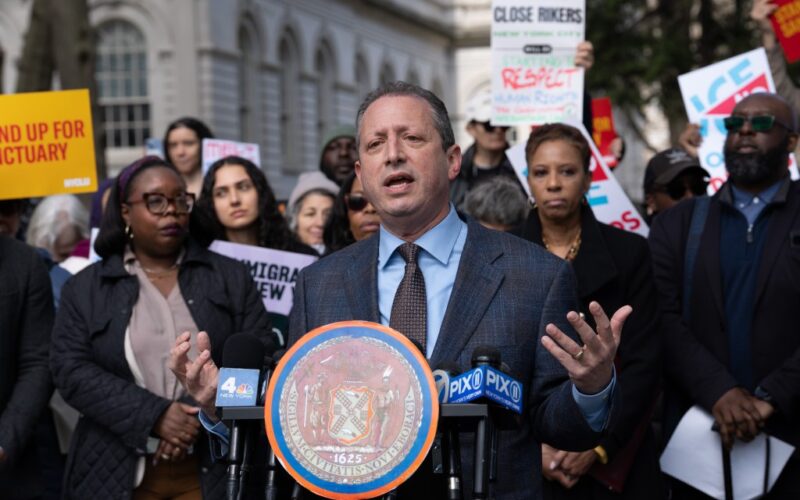Mayoral hopeful Brad Lander is making some very big public transit promises.
In a plan set to be rolled out Wednesday, Lander is pledging, if elected, to ensure that no New York City straphangers wait longer than 6 minutes for a subway train or longer than 8 minutes for buses on dozens of lines. That would make for drastic improvements as compared to the sloggy status quo.
To make those ambitious goals a reality, Lander’s plan floats a drastic operational shift: wrestle control of the subway and bus systems from the state-run MTA and place them under the mayor’s purview via a brand new city agency, Big Apple Transit.
Speaking to the Daily News on Tuesday, Lander acknowledged he doesn’t yet have a firm framework for how to launch Big Apple Transit, saying he’s at this stage seeking to “explore” the concept.
“The goal is to be as ambitious as we can,” said Lander, a progressive Democrat and the city’s current comptroller.
His plan, shared exclusively with The News before the rollout, argues letting Big Apple Transit become the steward of subways and buses would improve service because municipal control aligns “transit decisions with the specific needs” of city residents and ensures “policies and investments directly reflect community priorities.” A Lander adviser said conversations with Andy Byford, the Metropolitan Transportation Authority’s beloved ex-subway chief, inspired him to include the proposal in his plan.
But the blueprint doesn’t explain how Big Apple Transit would be funded or provide a timeline for such a massive overhaul.
The MTA, which took over operations of the city’s subways and buses in the 1960s, gets an annual operating budget of nearly $20 billion. The state provides the bulk of that funding.
When pressed for details on how he would bankroll his envisioned new agency, Lander said the state should still play a role.
Placing the city’s transit systems under municipal control is a concept that has been bandied about before without success.
In 2019, when Lander was a City Council member, then-Council Speaker Corey Johnson floated a plan to create essentially the same agency. Johnson’s plan also proposed naming it Big Apple Transit and specified it would absorb the MTA’s “New York City Transit, the Manhattan and Bronx Surface Transit Operating Authority, the MTA Bus Company, the Staten Island Rapid Transit Operating Authority, MTA Bridges and Tunnels, and a portion of operations at MTA Headquarters.”
Lander’s plan hyperlinks to Johnson’s roadmap and lifts the verbatim language from it in explaining which MTA entities he would like Big Apple Transit to take over.
Lisa Daglian, head of the Permanent Citizens Advisory Committee to the MTA, said getting Big Apple Transit on track could be a tall order.
“Both the devil and the angel are in the details,” she said. “It’s an ambitious plan.”
Lander’s roadmap is one of the first transit plans released by a candidate in June’s crowded Democratic mayoral primary, which ex-Gov. Andrew Cuomo is a favorite to win.
Lander’s plan is light on many details, though.
It simply says Lander would achieve 6-minute maximum subway wait times by leveraging “City Hall’s influence to ensure the MTA delivers signal improvements, new train cars, real-time train arrival and elevator status info, and service expansions.” As for the promised improved bus times, Lander’s document only says he’d “work with the MTA” to fund “more frequent service on at least 50 bus routes throughout all five boroughs.”
Besides the pledges to improve subway and bus times, Lander’s 29-page roadmap includes a slew of reforms to other parts of the city’s public transit and public space infrastructure. Among these are vows to make the city’s outdoor dining program year-round, complete several bike lane and street safety projects that have stalled under Mayor Adams’ administration and negotiate with Lyft to make Citi Bike memberships available at $5 per month for low-income New Yorkers.
On another cost front, Lander proposes instituting a $2.90 flat fare for riding on Long Island Rail Road and Metro-North trains anywhere within the city, a drop from the current $5.
To incentivize public transit over driving, Lander also wants to “offer free transit passes” to anyone with tickets to major events, like concerts and sport events, including the 2026 World Cup, which is expected to bring hundreds of thousands of tourists to the city.
For city government workers, Lander wants to offer a special credit to those who are eligible for parking placards but decide to rely on public transit instead. Such workers, including cops, teachers and firefighters, would instead get “the equivalent cash value” of a placard under Lander’s plan, but it doesn’t say how big such a stipend would be.








